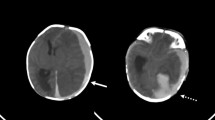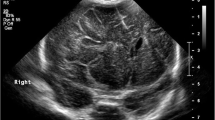Abstract
In order to evaluate the treatment and prognosis of subdural hematoma in neonates, we analyzed 48 survivors in the 3-year period January 1979 to December 1981. Based on the CT findings, the hematomas were grouped into four types according to location: type I, localized around the posterior interhemispheral fissure (25 cases, 52%); type II, extending from the posterior interhemispheral fissure to the hemispheric convexity (5 cases, 10%); type III, extending from the incisura to the posterior fossa (15 cases, 31%); and type IV, subdural hematoma accompanied by intracerebral hemorrhage (3 cases, 7%). Intracranial pressure was measured via the anterior fontanel in 13 cases. In 10 cases of extensive hemorrhage, the pressure exceeded 200 mm H2O. The age of the patients was from 0 to 7 days. There were 36 mature (75%) and 12 premature (25%) infants. The mothers were primiparous in 27 cases (56%). Fetal presentation was cephalic in 38 cases (79%), in 10 of which (21%) suction delivery was performed, and breech in 11. The fundus oculi was examined in 32 cases. Retinal hemorrhage was noted in 12 cases; it did not correlate with the type of hematoma or the intracranial pressure. Operations were performed in 13 cases; 1 of type I, 4 of type II, 5 of type III, and 3 of type IV. Functional prognoses were found to be as follows: type I, normal 15, abnormal 4, undetermined 6; type II, normal 4, abnormal 1; type III, normal 13, abnormal 1, undetermined 1; type IV, normal 1, abnormal 2 cases.
Similar content being viewed by others
References
Abraham IF, McLennan JE, Mandel F (1977) Acute neonatal subdural hematoma following breech delivery. Am J Dis Child 131:192–194
Bergen R, Margolis S (1976) Retinal hemorrhage in the newborn. Ann Ophthalmol 8:53–56
Courville CB (1971) Birth and brain damage. Farnsworth Courville, Pasadena, Calif, pp 408–515
Gröntoft O (1953) Intracerebral and meningeal hemorrhage in perinatally diseased infants. II. Meningeal hemorrhages. A pathologico-anatomical and obstetric study. Acta Obstet Gynecol Scand 32:458–498
Haller ES, Nesbitt REL Jr (1956) Clinical and pathologic concept of gross intracranial hemorrhage in perinatal mortality. Obstet Gynecol Surv 11:179–204
Hayashi T, Hashimoto T, Kuramoto S, Anegawa S, Honda E, Ishibashi A, Oshima Y, Nakashima O (1982) Analysis of ICP pattern in newborn infants with intracranial hemorrhage. In: Paraicz E (ed) ICP in infancy and childhood. (Monographs in paediatrics, vol 15) Karger, Basel New York, pp 72–74
Hayashi T, Kuramoto S, Oshima Y, Hashimoto T, Tunosue M, Okudera T (1983) Clinical analyses of neonatal subdural hematoma secondary to birth trauma. Child's Brain 10:141–144 (abstr)
Holland E (1922) Cranial stress in the foetus during labour and on the effects of excessive stress on the cranial contents; within analysis of eighty-one cases of torn tentorium cerebelli and subdural cerebral haemorrhage. J Obstet Gynecol Br Emp 29:549–571
Honda E, Hayashi T, Kuramoto S, Shojima T, Anegawa S, Ishibashi A, Oshima Y, Nakashima O (1982) Non-invasive measurement of ICP via the anterior fontanelle by miniaturized transducer. In: Paraicz E (ed) ICP in infancy and childhood. (Monographs in paediatrics, vol 15) Karger, Basel New York, pp 12–16
Kuramoto S, Shirouzu T, Hayashi T, Honda E, Shojima T, Anegawa S, Oshima Y, Nakashima O (1982) Analysis of intracranial pressure in neonates and infants. In: Brock M (ed) Modern neurosurgery, vol 1. Springer, Berlin Heidelberg New York, pp 64–70
Natelson SE, Sayer MP (1973) The fate of children sustaining severe head trauma during birth. Pediatrics 51:169–174
Pape KE, Wigglesworth JS (1979) Haemorrhage, ischemia and the perinatal brain. Spastics International, London, pp 61–84
Planten JTH, Schaaf PC (1971) Retinal hemorrhage in the newborn. Ophthalmologica 162:213–222
Schipke R, Riege D, Scoville WB (1954) Acute subdural hemorrhage at birth. Pediatrics 14:468–474
Sulamaa M (1951) An investigation into the occurrence of perinatal subdural hematoma; its diagnosis and treatment. Acta Gynecol 31:400–412
Takagi T, Fukuoka H, Wakabayashi S, Nagai H, Shibata T (1982) Posterior fossa subdural hemorrhage in the newborn infant as a result of birth trauma. Child's Brain 9:102–113
Towbin A (1970) Central nervous system damage in the human fetus and newborn infant. Mechanical and hypoxic injury incurred in the fetal-neonatal period. Am J Dis Child 118:529–542
Author information
Authors and Affiliations
Rights and permissions
About this article
Cite this article
Hayashi, T., Hashimoto, T., Fukuda, S. et al. Neonatal subdural hematoma secondary to birth injury. Child's Nerv Syst 3, 23–29 (1987). https://doi.org/10.1007/BF00707189
Issue Date:
DOI: https://doi.org/10.1007/BF00707189




